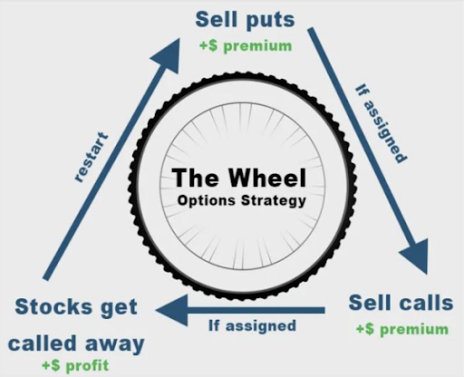More than anything, there’s been one concept that’s allowed me to successfully trade options for more than 25 years.
Keep it simple.
In other words, instead of trying to outsmart the market, I stay methodical and allow my time-tested strategy to do the heavy lifting.
And it works.
It’s a resilient and consistent strategy that’s intended to operate in any market conditions, and it’s simple.
The goal of the strategy is to bring in options premium on a continual basis. By doing so, we have the ability to use the premium for income, or to simply lower the cost basis of our position. How we choose to use the premium is ultimately up to each individual.
The strategy?
The Wheel
The wheel options strategy is an inherently bullish, mechanical, options income strategy known by various names. The covered call wheel strategy, the income cycle, and the options wheel strategy are just a few of the many names that investors use. But one thing is certain: The systematic approach remains the same.
More and more investors are choosing to use the wheel options strategy over a buy-and-hold approach because it allows you to create a steady stream of income on stocks you want to or already own.
The mechanics are simple.
- Sell Cash-Secured Puts on a stock until you are assigned shares (100 shares for every put sold)
- Sell Covered Calls on the assigned stock until the shares are called away
- Repeat the Process!
Basically, find a highly liquid stock that you are bullish on and have no problem holding over the long term. Once you find a stock that you’re comfortable holding, sell out-of-the-money puts at a price where you don’t mind owning the stock.
Keep selling puts, collecting even more premium, until eventually you are assigned shares of the stock, again, at the strike price of your choice. Once you have shares of the stock in your possession, begin the process of selling calls against your newly issued shares. Basically, you are just following a covered call strategy, collecting more and more premium, until the stock pushes above your call strike at expiration. Once that occurs, your stock will be called away, thereby locking in any capital gains, plus the credit you’ve collected.
Let’s go through an example to show you exactly how this options income strategy works.
Step One:
Identify a highly liquid stock, like DraftKings (DKNG), which is currently trading for 47.95.
Let’s say we are comfortable owning shares of DraftKings approximately 10% below where the stock is currently trading.
As a result, we decide to sell May 17, 2024, puts at the 44 put strike, 8% below the current stock price.
We can sell to open the 44 puts for roughly $2.06.
But before I go any further, I want to point out an important aspect of placing a trade. Never sell at the bid price and never use a market order. Always use a limit order. All research shows that taking this approach will tack on a significant percentage to your account over the long haul. Be efficient and don’t give up easy returns; work your orders!
By selling the 44 puts for $2.06 our return is 4.7%, cash secured. Our breakeven stands at 41.94 per share and will continue to decline every time we sell premium.
If DKNG stays above our 44 put strike at expiration, we begin the process of selling puts again, thereby creating more premium to use as income or to lower the cost basis of our position. So, if we bring in 4.7% every 60 days or so, and we can sell puts roughly six times over the course of a year (if the stock stays above our chosen short put strike) our annual return is 28.2% on a cash-secured basis. Again, it bears repeating, we can use that capital to either produce a steady stream of income or to lower the cost basis of our position. In our case, we are selling premium to lower the cost basis of a stock that we want to own.
But what if DKNG closes below our put strike?
No biggie. We are issued or assigned shares at the price where we wanted to buy the stock. Think about it for a sec. We collect a premium to wait for a stock to hit our chosen price.
Step Two
So, let’s say DKNG closes below our 44 put strike at expiration. If so, we are issued 100 shares at $44 for every put contract we’ve sold.
Once we have shares in our possession, we begin the process of selling out-of-the-money calls against our shares, which begins the covered call portion of the wheel options strategy on DKNG.
Now the question is which call strike to choose. Again, ultimately it just comes down to preference. My preference is to focus on call strikes that have a delta between 0.20 to 0.40.
Let’s say we decide on selling the 55 calls against our newly issued DKNG shares for roughly $1.70 per call contract.
Our static return or return on capital is 3.5% over 57 days.
If DKNG stays below our 55 call strike at expiration we begin the process of selling calls again, thereby creating more premium to use as income or to lower the cost basis of our position. So, if we bring in 3.5% every 60 days, and we can sell calls roughly six times over the course of a year (if the stock stays below our chosen short call strike) our annual return is 21%. Again, it bears repeating, we can use that capital to either produce a steady stream of income or to lower the cost basis of our position.
But what if DKNG closes above our short call strike?
Again, no big deal. Our shares are called away, so of course, we keep our $170 per call contract, plus we are able to reap any capital gains from our stock.
Once our shares are called away, the wheel options strategy cycle ends, and the decision has to be made whether or not to continue using the strategy with the same stock.
The wheel options strategy is one of several wonderful options income strategies for those wanting to generate steady income, with lower risk compared to most options strategies. It also gives the investor an opportunity to lower the overall cost basis of a position.
The strategy isn’t a get-rich-quick strategy; rather, it’s a methodical, systematic approach to trading options that generate consistent returns, month after month, on stocks or ETFs that you want to hold in your portfolio over the long term.

